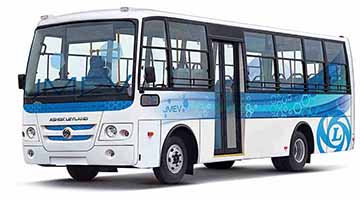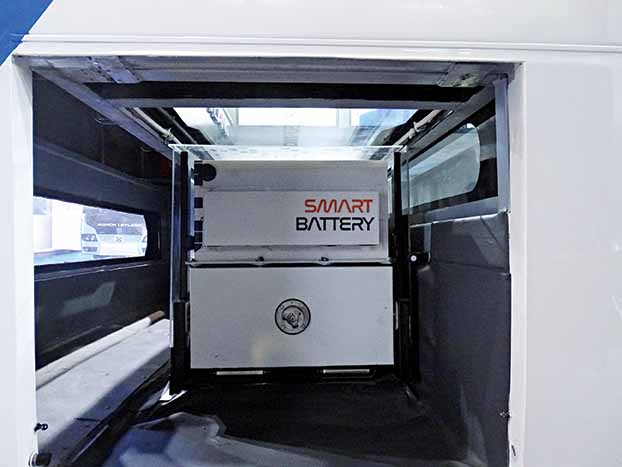Bhargav TS
From the time of unveiling the Circuit nine-meter electric bus in 2016, to the successful bagging of orders from two public transport undertakings in the country, Ashok Leyland has clocked a good deal of kilometres on the road to electric mobility. Gaining experience for every kilometer that it is travelling, the CV major is working on electric concepts. These include Light Commercial Vehicles (LCVs) and buses. Through a strategic alliance with Sun Mobility, the company is drawing ambitious plans to climb up the electric CV ladder in India. Aligning the same in line with the big shifts that are taking place in the powertrain technologies as well as the market demand and customer preferences, Ashok Leyland is closely observing the shift. It, according to Dr. Seshu Bhagavathula, the Chief Technology Officer, is exploring new ways to design and develop electric CVs. Expressing an opinion that India has miles to go before a complete shift to e-mobility takes place, he mentioned that the lack of access to battery materials is one of the big challenges. This involves both, original or processed materials, he added. Of the opinion that China has lithium deposits, Dr. Seshu mentioned that it has secured a future for EVs for a minimum of 100 years.

Revealing that China has taken over countries like the Republic of Congo economically where some of the raw materials are available in abundance, Dr. Bhagavathula revealed that India is talking to Bolivia. Bolivia, he mentioned, has lithium deposits. Asserting a need to secure access to raw materials, he stated that this is essential to compete technologically in the area of hardware. With a large number of leading players expressing interest to conduct business in India because of the market size and demand, Dr. Bhagavathula expressed that the ‘Make in India’ policy calls for a need to pursue electric vehicle development in a holistic manner. “The need is to look at all the aspects like electricity sources and charging infrastructure among others,” he added. Expressing a view that all the leading players are interested in India since they could sell their technology and products, Dr. Bhagavathula said that there is a need to look at greener mediums to generate electricity rather than burn coal. The act of burning coal to charge batteries is terrible, he said. “There is a need to look at a whole new value chain. Only a part of this is there,” he added.
Advantage FAME II
Confident of shared mobility (transport) profiting from FAME-II, Dr. Bhagavathula explained that buses will (and should be) the first to go electric. Two-wheelers, three-wheelers and passenger cars would follow, he stated. Drawing attention to the charging infrastructure, he expressed a need to set stations everywhere. “There may not be enough space in all gas stations. One solution is to get individuals to set up charging stations in front of their houses and run it as a profitable business,” he averred. Of the opinion that charging stations could be established along the highway dhabas, Dr. Seshu mentioned that people will take to it once they understand the viability of it. With electric sustainability important at a national level, the need is to look at each state electricity board working in tandem. The need is for them to work in tandem on issues like peak hour consumption and supply. Factors like these would have an influence on electric mobility, said Dr Seshu. Informing that FAME II needs correction since it is difficult for OEMs to operate profitably under the respective frame work, he called for cheaper funding with minimum or zero interest rate. “There should be subsidies for CO2 reduction, repair of e-buses, and for the number of people who resort to public transport by leaving their cars behind,” he added.

At the 2018 Auto Expo, Ashok Leyland announced its association with Sun Mobility to explore battery swapping. There is a good potential for the same, according to Dr. Bhagavathula. It is ideal for short distances, according to him, and could be deployed on short distance buses that do typically 30 to 40 km. Providing an advantage of reduction in overall cost of the bus because of the need for a small battery, battery swapping technology could get the bus to gain in terms of cost and range. It could make an ideal solution for travel between two short points like Ahmedabad and Rajkot, according to Dr. Seshu. “For a longer distance, a technology like this could prove to be expensive. Dozens of batteries will have to be invested into. As many batteries will need to be held as well,” said Dr. Bhagavathula. Revealing that Ahmedabad is the first city to experiment with battery swapping technology, he mentioned that four Series-1 (Ashok Leyland Circuit) buses have been introduced in Ahmedabad. In addition, one or two buses are being delivered to the city every week. Clocking over 10,000 km, these buses, said Dr. Seshu, are helping accumulate an amount of data. Data, that will provide an opportunity to progress. Especially, with an amount of stress being put on activities like fine-tuning of electric mobility technologies.
Electric vehicle supply chain

In discussion in Tamil Nadu, Ashok Leyland is looking at a proposal to own and operate buses by outsourcing battery swapping technology to another company. By doing so, it is looking at generating a good deal of data involving no less than 50 buses. Keen to study the effect of climate on electric CVs, Ashok Leyland is seeking more information. This would help it to further fine-tune electric propulsion technologies. Conducting trials in hilly regions to emerge as a national-level player in e-buses, Ashok Leyland, said Dr. Bhagavathula, is looking at developing a robust supply chain network that would include motor and battery suppliers. Keen to procure India-validated motors and batteries in the interest of them better enduring the local weather and road conditions, Ashok Leyland is looking at safety and security. Mentioned Dr Seshu, “It may not be worth procuring such components from foreign markets for local deployment. The need is to set up a supply chain in the next three to five years that could supply inverters, e-axles, battery management systems, charging stations and other infrastructure.”

Underlining the need for local procurement of components, which are validated and sourced locally, Dr. Bhagavathula mentioned, “Apart from safety and security, this would increase the confidence of the auto components industry to produce battery cells locally. If this is achieved, companies will come to India and make battery cells, he added. Stating that it is not easy, but not impossible either, Dr. Seshu said that the Indian companies may not make cells since it is expensive and capital intensive, they could very well make a motor. Of the opinion that NFTDC has all the ingredients to make a motor, he revealed that Ashok Leyland is working with them. “We will design the motors and they will make them. We are in talks and working on preliminary projects, he informed. Expected to take time, such efforts would propel Ashok Leyland CVs down the electric road with an ability to be globally competitive and class leading. Drawing attention to 125000 connected Ashok Leyland trucks out on the road, Dr Bhagavathula said, “We know the parameters. We have the ServiceMundy, and we are coming up with other apps. that can locate not just where the truck is, or diagnose what might have gone wrong, but also have the ability to help drivers in many other ways.
Connected CVs

Drivers of Ashok Leyland trucks are given a small bluetooth device that could be connected to a circuit in the vehicle. Doing this would help detect the vehicle. By using the device, the driver would receive a suggestion on what could be done. He could connect to a nearby service station as well. He could do so with the number in the app. Keen to see platooning first being deployed in the mining sector, Dr. Bhagavathula averred, “It is very expensive, and even though it may concern a prototype.” Revealing that technologically they have got electronic steering, distance control, and other bits like lateral measurement, which control the vehicle’s left and right movement, Dr Sehsu explained that it is difficult to manage if at some point the lead truck goes out of sight in a turn or during a similar maneouvre. Of the opinion that technologies like platooning need to be developed carefully, including BSVI, Dr Bhagavathula stated that they are running eight projects on the engine side. He informed, “With BSVI, you will see the whole HP moving up. We have already prepared for 360 hp. We are going to go beyond that.” “With the new axle norms, the weight (of CVs) has gone up by six to seven tonnes. We would therefore like to give each sector 20 HP more. 60 HP will be more than enough for the next two jumps,” Dr Seshu explained.

With one new cylinder required to go up by 40 hp, Ashok Leyland is expected to conduct a slew of launches once BSVI emission norms are enforced. These would begin with the launch of the first BSVI engine. On the vehicle side, the migration would involve legislation. What will make it exciting is a range of new technologies like driving assistance among others. In terms of functionality, the CVs, post the migration to BSVI, will not witness a drastic change in functionality, according to Dr. Bhagavathula. “The difference will be in price and in the extraordinary performance,” he concluded.

























